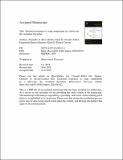Files in this item
Territorial responses to song components in a suboscine, the vermilion flycatcher
Item metadata
| dc.contributor.author | Ríos-Chelén, Alejandro A. | |
| dc.contributor.author | Crisanto-Téllez, Lilián G. | |
| dc.contributor.author | Quiros-Guerrero, Esmeralda | |
| dc.contributor.author | Rivera-Caceres, Karla D. | |
| dc.date.accessioned | 2019-06-21T23:41:20Z | |
| dc.date.available | 2019-06-21T23:41:20Z | |
| dc.date.issued | 2018-06-22 | |
| dc.identifier | 253425815 | |
| dc.identifier | d77c696e-3c62-4fd1-9ce4-d9834fac6d36 | |
| dc.identifier | 85049098865 | |
| dc.identifier | 000452570200063 | |
| dc.identifier.citation | Ríos-Chelén , A A , Crisanto-Téllez , L G , Quiros-Guerrero , E & Rivera-Caceres , K D 2018 , ' Territorial responses to song components in a suboscine, the vermilion flycatcher ' , Behavioural Processes , vol. In press . https://doi.org/10.1016/j.beproc.2018.06.012 | en |
| dc.identifier.issn | 0376-6357 | |
| dc.identifier.other | RIS: urn:5E30267F92ECFA13DD05F53D1929AD79 | |
| dc.identifier.uri | https://hdl.handle.net/10023/17948 | |
| dc.description.abstract | Vermilion flycatchers songs are composed of two acoustically different parts: a first part (FP) containing a variable number of introductory elements, and a second part (SP) composed of four elements. Previous work suggests that the FP is important for territorial competition and that it conveys information on threat level. By exposing free-living males to playbacks of complete songs (CS’s), FP’s and SP’s, we evaluated the relative contribution of each song part in males’ territorial responses. Males called in response to all three treatments, suggesting each song component is important for territorial competition. Males’ call response did not differ toward CS’s and FP’s, and toward CS’s and SP’s (although a non-significant tendency was found for SP’s to elicit a weaker response than CS’s), but it was greater toward FP’s than toward SP’s. These results, coupled with previous work, further support the idea that the FP plays a special role during territorial competition and may give information on level of threat. We further discuss our result in terms of mechanistic and functional hypotheses. | |
| dc.format.extent | 462464 | |
| dc.language.iso | eng | |
| dc.relation.ispartof | Behavioural Processes | en |
| dc.subject | Key words | en |
| dc.subject | Suboscine | en |
| dc.subject | Vermilion flycatcher | en |
| dc.subject | Territorial competition | en |
| dc.subject | Bird song | en |
| dc.subject | Pyrocephalus rubinus | en |
| dc.subject | QH301 Biology | en |
| dc.subject | NDAS | en |
| dc.subject.lcc | QH301 | en |
| dc.title | Territorial responses to song components in a suboscine, the vermilion flycatcher | en |
| dc.type | Journal article | en |
| dc.contributor.institution | University of St Andrews. School of Biology | en |
| dc.identifier.doi | 10.1016/j.beproc.2018.06.012 | |
| dc.description.status | Peer reviewed | en |
| dc.date.embargoedUntil | 2019-06-22 |
This item appears in the following Collection(s)
Items in the St Andrews Research Repository are protected by copyright, with all rights reserved, unless otherwise indicated.

